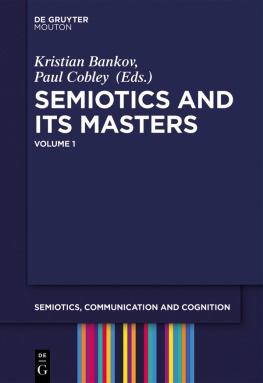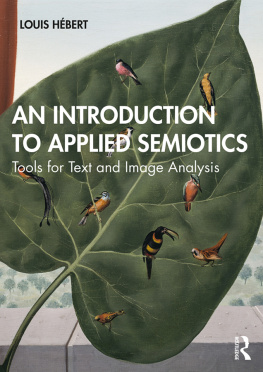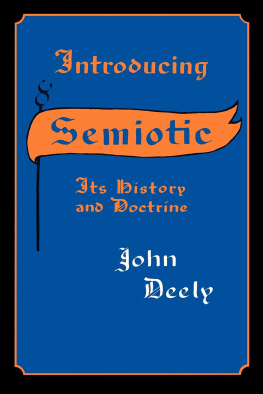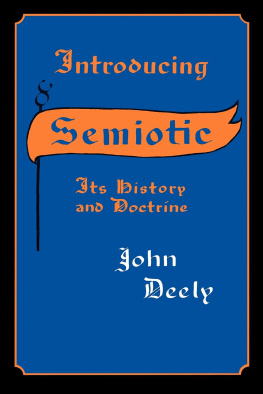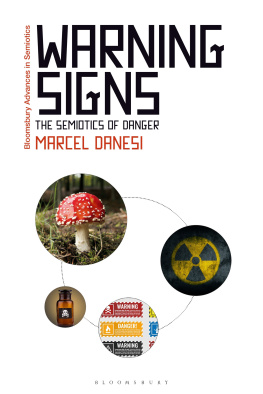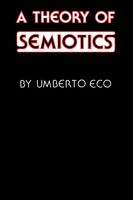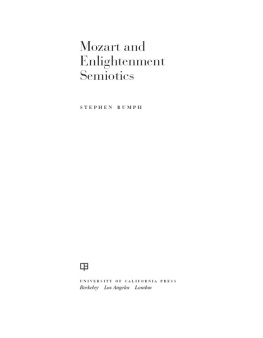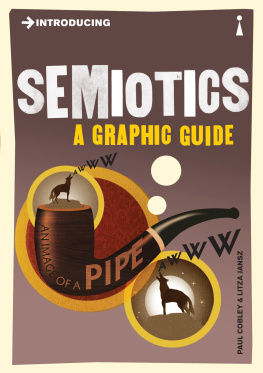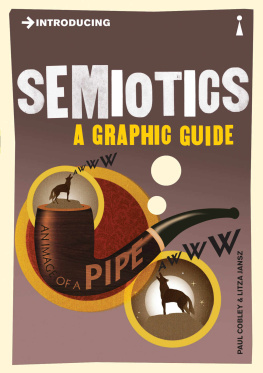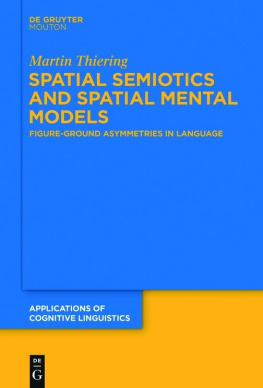Bankov Kristian - Semiotics and its masters. Volume 1.
Here you can read online Bankov Kristian - Semiotics and its masters. Volume 1. full text of the book (entire story) in english for free. Download pdf and epub, get meaning, cover and reviews about this ebook. City: Berlin, year: 2017, publisher: Walter de Gruyter & Co., genre: Romance novel. Description of the work, (preface) as well as reviews are available. Best literature library LitArk.com created for fans of good reading and offers a wide selection of genres:
Romance novel
Science fiction
Adventure
Detective
Science
History
Home and family
Prose
Art
Politics
Computer
Non-fiction
Religion
Business
Children
Humor
Choose a favorite category and find really read worthwhile books. Enjoy immersion in the world of imagination, feel the emotions of the characters or learn something new for yourself, make an fascinating discovery.
- Book:Semiotics and its masters. Volume 1.
- Author:
- Publisher:Walter de Gruyter & Co.
- Genre:
- Year:2017
- City:Berlin
- Rating:4 / 5
- Favourites:Add to favourites
- Your mark:
- 80
- 1
- 2
- 3
- 4
- 5
Semiotics and its masters. Volume 1.: summary, description and annotation
We offer to read an annotation, description, summary or preface (depends on what the author of the book "Semiotics and its masters. Volume 1." wrote himself). If you haven't found the necessary information about the book — write in the comments, we will try to find it.
Semiotics and its masters. Volume 1. — read online for free the complete book (whole text) full work
Below is the text of the book, divided by pages. System saving the place of the last page read, allows you to conveniently read the book "Semiotics and its masters. Volume 1." online for free, without having to search again every time where you left off. Put a bookmark, and you can go to the page where you finished reading at any time.
Font size:
Interval:
Bookmark:

Kristian Bankov and Paul Cobley (Eds.)
Semiotics and its Masters
Semiotics, Commununication and Cognition

Edited by
Paul Cobley and Kalevi Kull
Volume 18

ISBN 978-1-5015-1175-2
e-ISBN (PDF) 978-1-5015-0382-5
e-ISBN (EPUB) 978-1-5015-0374-0
ISSN 1867-0873
Library of Congress Cataloging-in-Publication Data
A CIP catalog record for this book has been applied for at the Library of Congress.
Bibliographic information published by the Deutsche Nationalbibliothek
The Deutsche Nationalbibliothek lists this publication in the Deutsche Nationalbibliografie;
detailed bibliographic data are available on the Internet at http://dnb.dnb.de.
2017 Walter de Gruyter Inc., Boston/Berlin
www.degruyter.com
This volume gathers the papers of 18 of the most distinguished semioticians worldwide. Their contributions were presented as a series of lectures, entitled Semiotics and Its Masters during the 12 th World Congress of the International Association for Semiotic Studies (IASS/AIS) held in Sofia, Bulgaria. Following the promise of the title of the congress New Semiotics. Between Tradition and Innovation the conference organisers proposed this series of lectures as an innovative substitute for the conventional plenaries. The main rationale was quality and quantity . With the well-known form of plenaries we could have had a maximum of 10 such papers, whereas with just a quick look at the list of the regular participants of World Congresses we saw at least 40 scholars who had made significant and internationally recognized contributions in semiotics during the last few years. Finally 27 such master lectures were presented in Sofia, 18 of which are published here.
Thus, Semiotics and Its Masters was conceived to represent the current frontline research by leading semioticians. There were no requirements for the topics of the lectures to fit the overall Congress theme. Rather, we encouraged eclecticism: each of our authors was invited to share what s/ he considers among her/ his research as the most relevant for the discipline. The collection is representative for the most cutting-edge work in semiotics, but it projects as well the developments in the near future of the field.
Semiotics, humanities and culture at large are in a phase of accelerating change. New rules of the market, efficiency and public image have started to dominate every collective action, scientific research included. The institutional survival of many research disciplines which are not completely consonant with the rules of the new global economy is in danger. Semiotics is among these disciplines and its survival will have to rely more and more on the solidity of our community, on the network of people who identify as semioticians, who visit the world semiotic congresses, publish in semiotic journals, teach semiotic courses and follow the news on the IASS/AIS website (http://iass-ais.org). Semiotics and Its Masters is a tribune for the best of our community, those who can open new research horizons, inspire others, attract young researchers and thus strengthen the sense of our belonging. Our auspice is that this is the first volume from a series of masters lectures that will be published after each world congress of the IASS/AIS and with it the agenda of semiotics will be always reset.
The present collection of texts fulfilled and surpassed our expectations in respect of variety. There are representatives of all major schools and paradigms. For many of them it is the first time to be together in one volume. It was quite difficult to group the texts in Sections but at the end we are happy with our choices as far as they represent already an interpretative key for the state of the art of semiotics.
We open the book with a section of three papers, dedicated to the academic, institutional, and ethical role of semiotics Semiotics in the world and academia . With his paper Paul Cobley introduces us to an ongoing debate on the role of humanities in present day Western academic institutions. A debate which is rich in ideas on the side of the advocates for humanities, but poor in facts and policies in their favour. According to Cobleys analysis of the debate, on one side it has been useful because it revealed the ideology of the neo-liberal construction of the so-called real world, inhabited exclusively by hard-faced robots who devote themselves single-mindedly to the task of making money (Cobley, quoting Collini 2012: 144145). On the other hand the standard advocacy (or PR in the words of the author) in favor of the humanities relies very much on a standard humanistic vision which puts the individual in the centre of the debate. Thus the rule of the game stays on the liberal side, and the apparent opposition of values of the two sides always ends with the use-value of humanities where they are predestined to lose. Here Cobley introduces the semiotic perspective as an anti-humanist doctrine, inspired among many other by such anti-humanist thinkers as Peirce, Sebeok, Hoffmeyer and Deely. The pleasure of reading this text lies in the variety of arguments that transfer the debate on the role of humanities to a much more fundamental level. Such input from semiotics is its inherent interdisciplinarity , which questions the very opposition and conventional hierarchies between humanities and the other sciences. But most crucially it is the perspective of Agency and Umwelt which gives the continuity (rather than opposition) between the natural and cultural worlds that makes the difference in Cobleys defense of the humanities. Agency and Umwelt introduce the debate in an evolutionary perspective and its quite clear to see by analogy with the other species regarding how certain arrangements and behaviors might seem apparently counterproductive for a short term individualistic survival logic (like play and aesthetic acts) whilst in the long run they are evidently at the origin of enrichment of the living world, which gives more opportunities for survival as a species. Thus, the deep ethical foundation of humanities resides in the responsibility of our species not only for the enrichment of our own living world, but also for the life on the entire planet.
But these conclusions already bring us to the doctrine of Susan Petrilli and Augusto Ponzio on semioethics, quoted by Cobley. The two scholars from Bari participate in this book with an essential contribution which reflects and summarizes an important part of their research in the last two decades. Their paper Semioethics as a Vocation of Semiotics. In the Wake of Welby, Morris, Sebeok, Rossi-Landi begins with the outline of the famous notion of semiotic animal, which embodies the doctrine of semioethics and postulates the essential difference from conventional ethics. Such difference is revealed also in the Saussurean notion of sign contrasted with the sign in the Global Semiotics project of Thomas Sebeok. Saussure, following some dominant ideas of the marginal economics of his time, sees communication as an equilibrium-oriented exchange of signs, which presupposes the equivalence between the sign constituents the signifier and the signified. In semioethics such abstraction is unacceptable as far as its model of sign is based on the inevitable relation between meaning and value, in the same way as behind any market exchange there are social relations of production. The authors refer also to the critique of Bakhtin-Voloshinov of Saussures model of sign, a critique which introduces one of the most important notions for semioethics otherness . But the radical critique inherent in semioethics comes when the notion of otherness is augmented through Sebeoks axiom that semiosis and life coincide. Thus semioethics goes beyond the social and cultural, and helps to conceive a new form of humanism humanism of otherness , which is opposed to the dominating Western humanism of the self, of identity, the humanism of human rights, which sacrifices the rights of the other.
Font size:
Interval:
Bookmark:
Similar books «Semiotics and its masters. Volume 1.»
Look at similar books to Semiotics and its masters. Volume 1.. We have selected literature similar in name and meaning in the hope of providing readers with more options to find new, interesting, not yet read works.
Discussion, reviews of the book Semiotics and its masters. Volume 1. and just readers' own opinions. Leave your comments, write what you think about the work, its meaning or the main characters. Specify what exactly you liked and what you didn't like, and why you think so.

